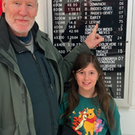A life well lived
To the Editor:
The obituary for Robert George Lewis, who died at 89 on Oct. 25, was very informative in providing the facts about his education, career, and the remembrances of his five children. However, I would like to provide some personal anecdotes relating to the humanity of the man we, at Milne High School, called Coach Lewis, that the obituary could not.
Coach Lewis came to us in early 1960 after the former coach, Harry Grogan, retired. The obituary mentions his tennis and basketball coaching but fails to tell you about other sports he encouraged that were new to the school.
Milne had neither the students nor the funds to form or field a football team. Coach Lewis saw the physical and character-enhancing benefits of cross-country running. Those of us who weren’t talented enough to make the basketball team, or strong enough to be successful in wrestling saw an opportunity to join this sport.
So the first junior team, consisting of Dick Blabey, Randy Hat, Dan Dugan, Chuck Eson (me), Dean Rundell, and Terry Thomas, started to train for and compete against other Class D schools. Our practices were held in Washington Park, across the street from Milne (now the University at Albany administrative offices).
I remember running in major races held in Schenectady’s Central Park, where the teams of six or seven lined up in a semicircle, focusing on a 10-yard-wide trail opening that narrowed to 5 then 3 yards, causing a major bottleneck of runners jostling for position. Coach Lewis warned us about this and suggested we try to stay within sight of each other, even if we wanted to surge ahead towards the front runners.
He suggested, wisely, that we could constantly move ahead of other runners until we established a comfortable pace. When there was a half- to an eighth-mile left in the race we should gather our remaining energy and stamina to run for the finish line.
Another yearly race the team ran was the invitational at Tawasentha Park (little did I know this venue would become my town park when I moved to Altamont). For those of you who have been to the park, you know there’s a steep 50-yard 40-degree incline. Races there included both running up and down this incline twice.
Also, the race-course designers decided to add running across the creek where the water depth during the fall was ankle deep. This, as you can imagine, was the most challenging of all courses we had to run. Coach Lewis stood at the bottom of the hill, speaking encouraging words to each of us as we went by.
One of my races in Washington Park was when I was a junior. Because there weren’t sufficient runners to form a sophomore team, he picked me as a fill-in. My pace allowed me to get ahead of all the other team’s runners.
I became overconfident and slacked off. Coach Lewis, standing near the finish, called out to me to look behind me. The top runner of the other team was gaining on me fast. I immediately poured on my speed and crossed the finish line half a foot ahead of the other runner. I had won the first and only race of my career because Coach Lewis believed in me.
A few years ago, the coach was invited to the 55th reunion for the Class of 1964, a get-together held at the Blabeys’ summer cottage. I learned that the coach lived in Voorheesville during the summer and early fall, and asked him if I could visit him.
Several times, we met at Emma Cleary’s for lunch before he left for Florida, and I got to know him personally. He was a wonderful listener and we conversed about things sports and non-sports.
I asked him, “How does an athlete whose sport depends on strength and stamina overcome the wall he (or she) encounters; the moment when his heart is racing and feels like it will explode, when the lactic acid has built up to extremely high levels and he feels he can’t take another step, leap another hurdle, cycle another hill, skate another shift, or climb another inch?”
He answered, somewhat cryptically, knowing I was asking for myself. Paraphrasing, he said: “You have to look within yourself and determine what your goal is. Are you really at the end of your ability, can you give a little more, has your training and practice prepared you for doing your best? Each athlete has to reach within themselves for the answer.” Wise words from a life well lived.
Charles Eson
Altamont

